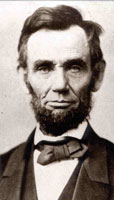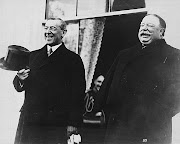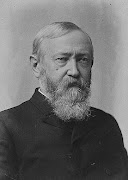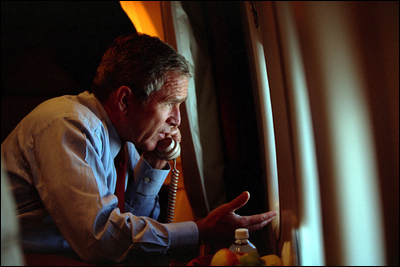 Years in office: 1841
Years in office: 1841Pre-service occupations: general, territorial representative, governor of Indiana Territory, U.S. representative, state senator, U.S. senator, minister to Colombia
Key event during his administration: his death, which created a crisis
Presidential rating: none, but very popular
ESSAY
William Henry Harrison has gone down in history as the answer to a couple of trivia questions, and that’s a shame. The questions:
 Who was the first president to die in office? (Harrison, of course)
Who was the first president to die in office? (Harrison, of course)Who had the shortest term? (Harrison’s term lasted one month: it ended on April 4, 1841.)
Who spoke the longest inaugural address? (At 8,445 words, his speech clocked in at close to two hours.)
Who had the most memorable campaign slogan of the 19th century? (Harrison’s primary campaign slogan was “Tippecanoe and Tyler Too.”)
But there was more to the man than trivia, of course. You are probably thinking, how can you assess a man who was in office for just one month? Easy. It’s not his time in office that I want to look at—make that can look at; it’s his campaign for that office (and President Martin Van Buren’s failed re-election campaign, for that matter). And besides, becoming president of the United States of America is no small thing. Only 42 men have achieved it, either in their own right or by default.
American politics would never quite be the same after the election of ol’ Tip in 1840, and his shocking death one month into his presidency. If Martin Van Buren set the stage for the modern political party, Harrison—or more properly, his Whig supporters—played a huge role in establishing a new type of election template: a candidate who was more style than substance.
That’s not to say that Harrison didn’t have substance, because some historians have lamented a presidency that never was and a road not taken. But the hype didn’t quite match the man, and in this current age of the “media anal exam” of every single cotton-pickin’ aspect of a candidate’s life, it’s fascinating to place Harrison the man and Harrison the candidate side by side.
The man was fascinating and quite qualified for the office, but he pales next to the larger-than-life rustic caricature hero his supporters created—which, it must be said, Harrison allowed to be created.
The hero of Tippecanoe
William Henry Harrison was Andrew Jackson’s contemporary, but their similarities are superficial. Both were western generals and Indian fighters. Both won famous battles, secured a section of the American frontier for future expansion and turned fame to political advantage. Both were seen as war heroes, though Jackson loomed larger than Harrison, as New Orleans truly was the bigger victory than Tippecanoe in all respects.
Still, when the Whigs selected Harrison as their champion in 1840, they couldn’t have done much better.
William Henry Harrison was born a British citizen, the last president to bear that distinction. But he harbored no love for the British: his father, Benjamin Harrison V, signed the Declaration of Independence. His father’s untimely death left him with no money to further his schooling, so young William (then 18) went west as a soldier where he gained a different type of education under “Mad Anthony” Wayne, one of the hardest fighting men in early America. Under Wayne, Harrison learned how to fight Indians, and he participated in the decisive battle of Fallen Timbers in the Northwest Territory in 1794.
Politics, however, soon beckoned, and at decade’s end, young William became secretary, then acting governor, of the new Northwest Territory. He was elected representative of the territory for a year, and then resigned to become governor of the Indiana territory (which then included Michigan, Wisconsin, Illinois and some of Minnesota). As governor, Harrison went after Indian lands, buying millions of acres from tribes and tribal leaders. Resentment against this expansion grew, however, and finally found an outlet under the leadership of Tecumseh and his brother, “The Prophet” Tenskwatawa, both Shawnees.
The trouble had been brewing for some time, with Tenskwatawa and Tecumseh attracting spiritual followers from many different tribes. In essence, it was a religious revival, with the goal of stopping the sale of land and resisting expansion. But other tribal leaders disagreed, refused to recognize the two Shawnee leaders, and continued to work with Harrison. Things came to a head when Tecumseh demanded that the treaty of Fort Wayne be rescinded in 1811. Harrison refused, but Tecumseh assured Harrison that he wanted peace and would not seek war.
While Tecumseh was away in the south recruiting among
 the “Five Civilized Tribes” (only the Creeks answered his call, and they would soon meet Andrew Jackson), Harrison was ordered to demonstrate (e.g., put on a show but not attack) against Tenskwatawa and his followers at Prophetstown along the Tippecanoe. This they did; but Tenskwatawa requested a cease fire for a peaceful meeting. Harrison agreed to meet the next day, Nov. 7, 1811.
the “Five Civilized Tribes” (only the Creeks answered his call, and they would soon meet Andrew Jackson), Harrison was ordered to demonstrate (e.g., put on a show but not attack) against Tenskwatawa and his followers at Prophetstown along the Tippecanoe. This they did; but Tenskwatawa requested a cease fire for a peaceful meeting. Harrison agreed to meet the next day, Nov. 7, 1811.But Tenskwatawa, fearing an attack, launched his own attack early the next morning, which Harrison and his men beat off. The American forces repulsed repeated charges all morning long, and Harrison’s men were left in command of the field when the Prophet’s warriors finally withdrew. On the morning of the 8th, Harrison’s men entered the deserted Prophetstown, which they burned. Harrison lost 68 killed and 126 wounded, while Tenskwatawa lost at least 50 killed and at least 70 wounded.
Thus was the great battle of Tippecanoe, the event that propelled William Henry Harrison to the presidency 29 years later.
But the legend was a little greater than the reality. Tippecanoe didn’t quite break Tecumseh’s confederacy, but rather seriously wounded it and embarrassed its leader. Tenskwatawa and Tecumseh would not meet final defeat until two years later during the War of 1812 at Harrison’s hands.
(Side note: there is absolutely no truth to the story that Tecumseh put a curse on Harrison that every president elected in a year ending in zero would die in office. The story is apocryphal and the deaths freak coincidences.)
Political career
Gen. Harrison built upon his reputation as an Indian fighter and soldier during the War of 1812, winning further victories in the Northwest. The real climax of his military career was a spirit-lifting smashing victory in Canada in 1813, the Battle of the Thames, where Tecumseh was killed. But he soon resigned from the army over disputes with Secretary of War Armstrong.
After the war, he turned to politics once more, and never looked back. Ohio elected him to the U.S. House, the state senate and the U.S. Senate. John Quincy Adams sent him to Colombia as minister in 1828, but Jackson’s election ended that posting the next year. In fact, there was bad blood between Jackson and Harrison, stemming from Jackson’s 1819 Florida incursion beyond the extent of his orders. Harrison was among the Congressmen who wanted to censure Jackson. Old Hickory, of course, never forgave Harrison.
The Whig Party, which formed in direct opposition to Jackson and the Van Buren Democrats, began to see Harrison as something of an anti-Jackson: a western war hero opposed to “King Andrew” and looking to undo the “excesses” of Jacksonianism. In 1836, Harrison did extremely well among four Whig candidates arranged against Jackson’s hand-picked successor, Van Buren. Harrison’s second-place showing in 1836 and his hero status convinced Whigs that Harrison was their go-to guy in 1840—especially because the Panic of 1837 had left the incumbent extremely vulnerable.
 The origins of the modern campaign
The origins of the modern campaignThe Whig Party finally ran a national campaign in 1840—and what a campaign it was. Harrison’s image during this campaign was brilliantly—if not expertly—crafted. And large parts of it were bald-faced lies.
Chances are, you’ve heard or read the phrase “Tippecanoe and Tyler Too” sometime in your life, whether in school, on TV, in a commercial, or as a passing reference. To this day, the phrase has staying power. It’s that good.
You might have heard of another one: “Log Cabins and Hard Cider.” And you, like countless other Americans, have undoubtedly used a third phrase that gained currency at the same time: OK (though this one was associated with Harrison’s opponent, Martin Van Buren. According to one story, Van Buren was supposedly called Old Kinderhook, or “O.K.”).
Martin Van Buren’s unpopularity, stemming from the crushing Panic of 1837, left him wounded and unpopular. It almost seems as if anyone could have waltzed in and defeated him—at least, anyone with a catchy slogan or two. But that didn’t stop Van Buren from campaigning hard, nor Democrats from ridiculing Harrison as a “granny” (too old) and as the butt of a joke (“Will we elect Harrison? No sirrah!” which is his name in reverse). On Democratic newspaper derided Harrison as someone who would simply sit around his log cabin drinking hard cider.
Harrison’s people—namely, the Whig press and the state
 party bosses—jumped on the log cabin and hard cider crack and brilliantly turned it to their advantage. Harrison, they claimed—stealing the Democratic press slur—was a rough-and-tumble westerner, born in a log cabin and very much at home drinking hard cider with the common man. “Log Cabins and Hard Cider” became one of the Harrison camp rallying cries. Actual log cabins were erected all over the country to serve as Harrison campaign headquarters.
party bosses—jumped on the log cabin and hard cider crack and brilliantly turned it to their advantage. Harrison, they claimed—stealing the Democratic press slur—was a rough-and-tumble westerner, born in a log cabin and very much at home drinking hard cider with the common man. “Log Cabins and Hard Cider” became one of the Harrison camp rallying cries. Actual log cabins were erected all over the country to serve as Harrison campaign headquarters.Of course it was a lie, as Harrison lived rather comfortably in a mansion and came from wealthy stock, while his opponent was the one who came from a family of quite modest means.
But it stuck. The theme of the common man against the wealthy continued throughout the campaign, which had to have stung Van Buren hard, considering it was the same theme that the Jacksonians used to gain power. The most biting was Whig Rep. Charles Ogle’s “Golden Spoon oration,” an often unintentionally hilarious diatribe against the president given on the House floor against the outrageous “opulence” of Van Buren’s White House while the common man suffered. Ogle praised Harrison and damned Van Buren, and distributed 10,000 copies of his hysterical, over-the-top and highly imaginative attack nationwide. Little of it was true, except for the list of (necessary) improvements that Van Buren did to the White House—which historians still consult to this day!
Certainly one of the stranger features of the campaign was the sight of Harrison supporters rolling huge leather balls at their rallies, signifying how the Harrison campaign was gaining momentum everywhere it went.
 Another staple of the campaign were the songs and rallies, which were actually family-friendly: women and children were welcomed at political rallies in large numbers for the first time (even though women’s voting rights was not on the Whig platform). Men and boys also wore coonskin caps to identify with Harrison’s supposed rustic roots.
Another staple of the campaign were the songs and rallies, which were actually family-friendly: women and children were welcomed at political rallies in large numbers for the first time (even though women’s voting rights was not on the Whig platform). Men and boys also wore coonskin caps to identify with Harrison’s supposed rustic roots.A typical campaign poster could feature Harrison at work on a farm, with a log cabin and barrels of hard cider nearby. Others would show a hapless “Maddy” Van Buren and other Jacksonians being outfoxed by “ol’ Tip” as Harrison showed them the way out of the White House.
But the most memorable aspect of the campaign was the chief slogan: Tippecanoe and Tyler Too. After winning the nomination at the Whigs’ 1839 convention (the party’s first), Harrison selected former Democrat John Tyler as his running mate. This marked another change in American politics, as the vice president was no longer going to run separate from the presidential candidate.
Tyler seemed closer to Whig Henry Clay in his views than Van Buren, and he was something of a “maverick,” to use the modern connotation, so the choice seemed safe. Harrison selected the Virginian to placate the South and also to avoid talking about slavery—or anything at all. Instead, Tyler became part of the most memorable slogan of the 19th century. It rhymed and celebrated an overblown battle that many people probably ranked below more important battles, such as New Orleans, Yorktown and Fallen Timbers. Harrison hung his hat on that battle, magnifying it to a fantastic and decisive victory, which helped deflect Democratic charges that Harrison was a “silk robe” general who quit the War of 1812 before it was over.
But it ultimately didn’t matter. Van Buren, the man more responsible than anyone else for the creation of the Democratic Party and party organization, was overwhelmed by the Harrison machine. Armed with memorable slogans, leather balls, log cabins, campaign songs and a hyped personality—style over substance—Harrison defeated Van Buren rather easily. Harrison took the popular vote by a 5% margin, but won the electoral college in a blowout.
The shortest presidency
But in a month, Harrison was dead. He caught a cold during his
 inaugural, and thanks to the demands of his new office—mainly office-seekers—and poor 1840s medical know-how, his cold turned to pneumonia. He died on April 4, 1841, the first president to die in office. His death created a constitutional crisis—which I’ll discuss in the next installment—and shocked the nation. Presidents had been sick before, but never had one actually died.
inaugural, and thanks to the demands of his new office—mainly office-seekers—and poor 1840s medical know-how, his cold turned to pneumonia. He died on April 4, 1841, the first president to die in office. His death created a constitutional crisis—which I’ll discuss in the next installment—and shocked the nation. Presidents had been sick before, but never had one actually died.What would his presidency have been like? Bruce Frohnen, an associate law professor at Ave Maria School of Law and co-editor of American Conservatism: An Encyclopedia, wrote in National Review Online in early February 2007 that Harrison was his favorite president:
"William Henry Harrison was only president for about a month. And he spent that month in a sick bed, dying of pneumonia. Why is he my favorite president? No other president has done so much to live up to the original intent of the framers, that ours was to be a republic, with a representative assembly at its center and at the apex of power. Ironically, Harrison entered office with the intention of increasing congressional responsibility and power. Unfortunately, his death brought in the Jacksonian John Tyler who sought to act as an Imperial President. But Harrison, in his plans and in his deeds, stood for a true, free republic, answerable to the people in their local constituencies, and not as some democratic mass speaking only through circus-like plebiscites held every four years. He valued our Constitution and its fundamentally localist, limited government principles over dreams of greatness for himself or his party. And it was those principles, and the customs they fostered, that made our country great."It is fascinating to speculate whether Harrison would have lived up to Frohnen’s expectations, and taken the country in a different direction than the 10th president, John Tyler. Would a full Harrison presidency have led the country away from war—both the Civil War and war with Mexico? We can only guess.
Final Assessment
Historians never rank Harrison with the other presidents because in his month-long service, he didn’t do anything with which to truly gage him against the others, except, perhaps, select an interesting and strong cabinet, which included the great orator Daniel Webster as secretary of state. But he did do something of lasting consequence, something for which America can be eternally grateful, at least in one respect: he selected John Tyler to be his vice president.
As I’ll talk about in my next installment, selecting Tyler was a tremendously fateful choice, because Tyler, the first vice president to assume the presidency upon the death of the chief executive, made sure that he became president.
And as the Whigs were to discover, “and Tyler Too” was very bad for their party.
Resources
Usually, you have to read about Harrison lumped in with other presidents and events. The most recent adult biography of him is 17 years old, as it seems Harrison is just not that interesting a person to modern America, despite the groundbreaking campaign of 1840.
So far, Arthur Schlesinger Jr.’s The American Presidents series has no entry for Harrison, although the web site promises to profile all 42 men who have served as president. The most recent resources are The Presidencies of William Henry Harrison and John Tyler (1989) by Norma Lois Peterson, part of the University of Kansas’ American Presidency Series, and Old Tippecanoe: William Henry Harrison and His Time (1990) by Freeman Cleaves.
Illustrations
All images are public domain and from the Library of Congress Prints and Potographs Division unless otherwise noted.
1. Official White House portrait
2. Charles Fenderich created this lithograph of William Henry Harrison circa 1841.
3. “The Tippecanoe Quickstep” was composed for the 1840 presidential campaign. The fanciful cover depicts Gen. Harrison “leading the charge” at the Battle of Tippecanoe on Nov. 6, 1811.
4. The National Whig Song, another 1840 campaign song, with the cover featuring William Henry Harrison
5. A campaign poster depicting real and imagined events from the life of the hero of the Whigs
6. William Henry Harrison - Late President of the United States, painted by James R. Lambdin and engraved by J. Sartain
7. An illustrated broadside announcing a “general meeting of the friends of Harrison & Reform” in Alton, Ill. on May 9, 1840. Harrison, in farmer's clothes and broad-brimmed hat, stands next to a plough. Behind him is a barrel of hard cider, a log cabin, and another log building or shed. Overhead an eagle flies a streamer bearing the slogan “William Henry Harrison. The Farmer of North Bend.”
8. Death of President Harrison, printed 1846








5 comments:
This is the most I have ever seen written about WHH. Interesting.
Can you take a spelling critque? You spelled the name of the country "Colombia" wrong, instead spelling it like the city in Missouri.
Fixed! Gracias. (I have now engaged the services of a "third eye" to check for spelling and etc.)
Can you enter the FOREX trade with little money? I want to invest. But I am sincerely lost and do not know where or how to start...
[url=http://www.youtube.com/watch?v=l_g8RMKfk5w]unlock iphone[/url]
Your blog keeps getting better and better! Your older articles are not as good as newer ones you have a lot more creativity and originality now keep it up!
federal consolidating student loan [url=http://loveepicentre.com/]diamond head singles[/url] understanding men and dating http://loveepicentre.com/ free datingsites with free membership
Post a Comment